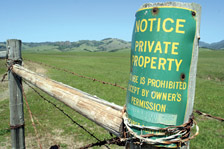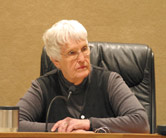Closing
the deal
The Hearst Ranch preservation project awaits public review before
historic agreement can be completed
STORY BY DANIEL BLACKBURN
PHOTOS BY CHRISTOPHER GARDNER
Few land parcels in America have attracted as much attention and created
as much hubris over the decades as the 82,000 acres of heaven on earth
known as the Hearst family ranch.
Quite apart from its famous castle and other hints of civilization, the
San Simeon ranch’s golden canyons, sweeping panoramas, breathtaking
ocean views, and miles upon miles of spectacular sandy beaches makes it
arguably one of the aesthetically premiere spots in this hemisphere.
And its value — environmental, cultural, and, yes, monetary — has made it a poster child of global proportion for the enduring philosophical and legal struggle between private property owners and public land advocates.
No small measure of the conflict is playing out right now in San Luis Obispo County and Sacramento, and the infighting has rubbed raw the bonds that once joined many environmental activists at the heart.
The issue is this: Shall the Hearst family’s proposal be accepted, to sell to the state of California — for $95 million — 1,400 acres of prime coastal property and a conservation easement that ostensibly would protect almost all of the remaining ranch from future development?
Even as a critical deadline came and departed earlier this month, many of the players in the unfolding Hearst land drama remained starkly divided on their opinions of what any deal should provide.
 |
OPENING SOON |
At the root of the division is deep distrust, so emotionally embedded in some people that nothing the Hearsts could offer, perhaps, would ever be well received. Such is the reach of suspicion.
The Hearst Corp.’s lead negotiator, Steven Hearst, reportedly became so angry with people who couldn’t see past the name “Hearst” that the deal almost died.
Hearst lawyer Roger Lyon was moved at one point during the jousting to suggest that the corporation might just turn its back on the environmentalists, scrub the deal, and deny public access to the corporation’s beaches. (The yet-to-be-finalized agreement grants irrevocable public rights to the beaches.)
Differences regarding the issue also have caused environmental activists to turn on one another like a school of blood-crazed piranhas.
Consider, for instance, the internecine conflict involving Tim O’Keefe, an Atascadero resident who sits on the executive committee of the Santa Lucia chapter of the Sierra Club.
After the Hearst deal was announced, the Sierra Club drafted its own “blueprint” for what should occur on the land, decided to oppose the Hearst’s plan as it is currently understood by members, and agreed to tinker with details.
For his part, O’Keefe used to be vice chair of the organization, but his outspokenness kept getting in the way and his role was downgraded last year.
O’Keefe penned a letter to the editor recently, asking his fellow club members to endorse the Hearst land plan and taking issue with the chapter’s official position on the controversy.
“I support the Sierra Club in most instances, but in this case I have my own opinion,” said O’Keefe.
Reaction was swift and brutal. O’Keefe has received a tersely worded letter of reprimand from Sierra Club officials in Sacramento and may face further discipline from local members for his candor.
The reprimand, from Bill Allayaud, state director, and Regional Staff Director Carl Zichella, informed O’Keefe that “it is of great concern that you decided to use your name with your Sierra Club title [in the letter to the editor] that contradicts the Sierra Club’s position on the Hearst Ranch deal.”
The one-page letter directed O’Keefe to “cease representing that you are speaking for [the club],” and called his action a “breach of leadership trust.”
The letter concluded with a threat of removing his name from membership rolls.
Suitably muffled, O’Keefe said last week, “I probably will comply with the request and try to smooth things over. I value my position on the board and I think I am more effective on the board than off.”
Another who has felt the sting of retaliation is San Luis Obispo County Supervisor Shirley Bianchi, who said her support of the land plan has attracted the vitriol of one-time brothers and sisters in the environmental trade.
 |
COMPROMISING POSITION |
“The reason the organized environmental community wanted to control this deal is that they want to be able to say they saved the Hearst Ranch. And they can’t say that. They’re just ride-alongs like the rest of us,” said Bianchi. “They have taken their eyes off the objective of saving the ranch, and put it on something else — like their saving of the ranch.”
Bianchi said she didn’t come to her support of the deal easily. But she has been “distressed” by the reaction of some environmentalists to her and others who displayed the temerity to cooperate.
“‘Do it my way or you are an evil person’ is what they are saying,” said Bianchi.
Directing her comments at several outspoken opponents of the plan, Bianchi added: “By their very nature, they are used to being against something. And they can’t suddenly be for something they have been against. I had a hard time with [reaching a conclusion on the proposal]. It was wrenching; I want that ranch not developed. I want kids in 100 years to be able to drive by and know how spectacularly beautiful it is.”
The supervisor said the plan has been threatened by “picky opposition over things that do not need to be decided at this time.”
“I’ll tell you the truth,” said Bianchi, “I didn’t trust Stephen Hearst when I met him, and he didn’t trust me.”
Bianchi, who fought the Hearsts on prior development proposals both as a supervisor and as a member of the county planning commission, reversed her initial opposition and become a supporter of the conservation easement after dealing with Steven Hearst over the past few years.
For her trouble and in spite of her lengthy environmental credentials, Bianchi endures her savaging by opponents of the plan.
In a recent letter to the editor, Bianchi was called “a wholly-owned subsidiary of the Hearst Corporation” by Kat McConnell of the California Coastal Protection Network (CCPN).
“This kind of thing is being said because I believe this deal should be looked at with positive thoughts, rather than negative,” Bianchi said. “It’s a good deal; how can we make it better? There are ways to make suggestions work. I would have preferred no development. And no hotel. But it’s not my call.”
Conservation deals like the one now being crafted between Hearst, the American Land Conservancy, and the state of California often are conducted privately, and because this purchase would be made with tax dollars the accompanying secrecy has generated considerable angst on the part of some people.
What is publicly known about the proposal was contained in a “framework” presented December 2002 by Stephen Hearst.
Hearst took over in 1998 the family corporate division that administers the ranch. His ascension to the post came on the heels of a lengthy, frustrating, but eventually successful development conflict between the corporation and the California Coastal Commission regarding construction of a 375-room hotel and a 60-room hostel on the property. That project is authorized by the Coastal Commission but has not been pursued.
Thus Hearst was faced with a fiscal dilemma: the ranch was under-performing economically, and that needed quick fixing. But the property, which has been in the Hearsts’ hands ever since George Hearst purchased the first 40,000 acres in 1865, has been a special retreat for five family generations that have enjoyed its private opulence.
Selling it outright was not an option.
Stephen Hearst’s proposed solution was based on the opinion of his legal and financial advisers that a conservation easement might work for everyone. That’s a legal device for restricting development.
The ranch’s development has long been a flash point for dissent. In 1965, the corporation had placed on the table a plan for creation of a 10,000-acre city of 65,000 people. Environmental conscience existed even then, apparently, because a groundswell of opposition eventually sank the concept. The Hearsts went back to ranching the land and staring at the ledger’s red ink.
So Stephen Hearst drafted his framework, which offers to give up most of the ranch’s development forever. The pending deal is said to be extensive and complicated.
Here is what is currently known about the deal:
Under its provisions, the corporation would forever be prohibited from building on most of the land.
The Hearsts could continue operating the largest cattle ranch on the California coast on the east side of Highway 1. Public access to the working ranch would continue to be prohibited. Hearst could build 27 homes on the east side, out of the view of the castle or highway. A 100-room inn on the coast at San Simeon Village — perhaps the most controversial element of the proposal — would be allowed. The corporation would sell title to 1,400 acres to the state — 13 of 18 miles of coastline now owned by Hearst. And public access to the beaches would be guaranteed in perpetuity.
For this, the Hearst Corp. would get $80 million in cash and $15 million in tax credits. Most of the money would come from voter-approved open space bonds. Caltrans recently agreed to chip in $23 million in federal money from other projects.
Authorization of the tax credit, however, has been delayed by the state’s budget problems.
The American Land Conservancy, which is negotiating with Hearst on the deal, got its own appraisal of the offer recently, and pegged its value at $200 million.
It is a delicate bond holding together tentative concurrence on the deal — at least, for the present.
 |
BACK TO SCHOOL |
Standing in the way of a sealed deal, in addition to environmental assault groups, is approval of a gaggle of yet-to-be-prepared legal documents now being prepared by the four public agencies, two non-profit organizations, and Hearst Ranch representatives. Formal agreement papers will be presented to authorizing boards later this summer, but dissent on the part of any of the entities could jeopardize solidification of the plan.
Public agencies that must pass the plan on to appointed boards for final approval include the Wildlife Conservation Board (WCB), the California Coastal Conservancy, and California State Parks. Nonprofits American Land Conservancy and the California Rangeland Trust also will be taking the matter before decision-makers.
California Resources Secretary Mike Chrisman, whose agency is overseeing the entire process, said the state and the Hearsts “have come a long way in reaching agreement on the key issues.”
In a statement, however, the secretary noted the work is not over.
“Concluding this multifaceted transaction will involve significant public process, including [open] meetings of the WCB and the Coastal Conservancy. Once [the plan is] consummated, I believe all Californians will be well served” by efforts to preserve the land, said Chrisman.
He also said the respective agreement documents, “along with the [complete] details of the proposed transaction, will be released for public review in advance of all public meetings.” That advance time has been set at 30 days. Some critics of the plan claim that is inadequate time to study the proposal.
On the surface, at least, Steven Hearst apparently has contained his anger: After the tentative deal was inked, he issued a statement saying his group “looks forward to completing documentation of our agreement and moving on to the next steps in the public process for discussing and approving the details of this plan.”
And Harriet Burgess, president of the American Land Conservancy, which brokered the anticipated deal, suggested in the same statement that the parties involved “have taken a big step forward on this … opportunity.”
SLO’s Bianchi said she hopes personal relationships will recover when the Hearst fight is over. And she said she regrets her first feelings toward Steven Hearst.
“I had a preconceived notion, and he was nothing like I thought he would be. It’s hard when you have categorized another person, to recognize there is a human being there. He wants the same thing we all do — preservation of that land.”
A bit wistfully, she said of the offer, “I hope it doesn’t
go sideways. This is in my mind a
terrific opportunity. Everyone in the world is looking at this deal.”
³
News Editor Daniel Blackburn can be reached at [email protected].